
|

|
Astronauts in Hard Hats Outer space is a heck of a place to build a home. Just ask the astronauts charged with assembling the International Space Station. For starters, it's alternately frigidly cold and dark as ink, then blisteringly hot and bright as a noontime desert—a climatic flip-flop that takes place every three-quarters of an hour. Below, see and hear six astronauts tell what it's like to "translate" (spacewalk) and otherwise cope with the largest construction project ever undertaken in orbit. For capsule biographies of the astronauts, click on their names.
"Building the space station is not an ordinary construction job. It's very different, and it's different from building a house or a skyscraper, in that we're working in a very hostile environment, a very isolated environment. So, first of all, we're not as efficient working in these big, bulky spacesuits. We're time-constrained, up to eight hours at a time. We're constrained on the amount of tools and weight we can carry to space. So there it's somewhat unique. "But part of the problem is, we have to have it all figured out before we show up in space. It's got to be all figured out, while on a construction site, if you're building a house and you cut a two-by-four to a certain length and you go to install it and it doesn't work, well, it might be a little inefficient, but basically you toss that board, you go cut another one, and you're off and running. If we show up in space, and now that piece that we're putting on doesn't fit, we're out of luck. That may have just delayed the next series of missions. We may have to add another mission now to bring up the right component, because they're all linked. So it's very complicated." -Kent Rominger
"That's what's fascinating about it. It is the environment in the end which is the challenge and not the mundane tasks. It's being able to go outside and to have only two people at a time typically, and to work in a vacuum with temperature extremes from -200°F to +200°F, and [going] from daylight, and 45 minutes later it's dark, 45 minutes later it's day." -Jim Newman
"What we call 'translating' around the space station, people call spacewalking. But, of course, you can't actually walk in space. There's nothing for your feet to walk on, in the sense of gravity holding you down to walk. What we end up doing is actually more of a space crawl. It's like climbing something that's going straight up. That is, you use your hands a lot, in fact, almost entirely, in order to move around the space station. So you grab ahold of one handrail, then you grab ahold of the next one. You let go of the last one, you grab the one you're on, you grab the next one. And that's literally how you do it, from one after the other handrail to wherever it is you're going. "There is one other way, and we call it the Elevator. That is, if you get on the end of the robotic manipulator system, on the end of the arm, it can actually take you wherever it is you need to go." -Jim Newman
"So if you have an electric drill as we did, and loosen a bolt, and you're not tied down with your feet or your hands, you can feel it trying to turn you the other way. So we have to react to all the torques ourselves, and there are two ways to do it: one with your feet in a foot restraint, or free-floating." -Jim Newman
"Training in the Neutral Buoyancy Lab [a swimming pool used for instruction before spaceflight] is very good training. It's harder in some ways than actually going outside, because of the gravity effects in the pool. Once we're in the pool, they put us in a spacesuit, a real spacesuit, and pressurize us ... and that's what really makes a lot of spacewalking difficult, because your hands are in this balloon. And you know that if you want to bend a balloon, it takes work. So every time you close your fingers or open your hands, you're actually working against the suit...The training in the tank is very important because it doesn't pay to fight the suit. The suit will win, so you have to learn how to be one with the suit." -Jim Newman
"The way the suit is designed, it's very protective, because, of course, you don't have anything out there. You're in your own little spacecraft, actually, when you're wearing this suit. So as a result of all the protections, it's kind of stiff. So essentially what they're doing is lifting weights for six to seven hours. And so obviously if the task is very intensive with their hands, then they're lifting even more weight. So there are times built in for them to rest. But from an endurance and a strength standpoint, it's an incredible workout." -Pam Melroy
"Now, we have a device called the Secondary Oxygen Pack on the back of our backpack, and it's got a whole lot of oxygen in it, and it would be able to support a small leak for—depends on how small it is—but for at least 30 minutes. So for a small leak, we'd have our secondary-oxygen system kick in, and we'd be heading back to the airlock and repressurizing, and we'd be fine. A big leak—like a big hole in the suit, say a half-inch hole or something like that, or if your glove blew off—would pretty much be a real bad day for you." -Mike Gernhardt
"Your safety tether is like a reel. It's a wire tether on a spring-loaded spool that tends it, and that is attached to you and the space station at all times, because if you should ever let go of the station, the tether will pull you back in, or you can grab it and pull yourself back in. If you didn't have that tether and you let go, even if you're two inches away from the station, you can't swim over there. There's no water to create forces against. So it's critical from a safety perspective that you be tethered at all times." -Mike Gernhardt
Blueprint for a Space Station | Astronauts in Hard Hats Inspired by Science Fiction | Free-Falling | Resources Transcript | Site Map | Stationed in the Stars Home Editor's Picks | Previous Sites | Join Us/E-mail | TV/Web Schedule About NOVA | Teachers | Site Map | Shop | Jobs | Search | To print PBS Online | NOVA Online | WGBH © | Updated November 2000 |
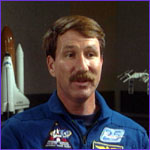 See Kent Rominger in
See Kent Rominger in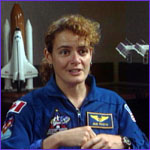 See Julie Payette in
See Julie Payette in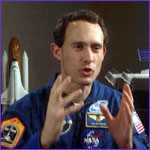 See Jim Newman in
See Jim Newman in See Rominger in
See Rominger in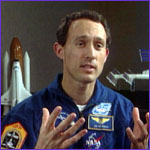 See Newman in
See Newman in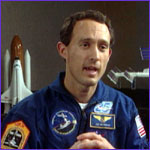 See Newman in
See Newman in See Mike Gernhardt in
See Mike Gernhardt in See Newman in
See Newman in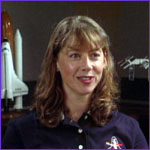 See Pam Melroy in
See Pam Melroy in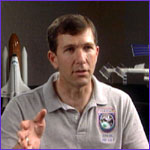 See Rick Husband in
See Rick Husband in See Gernhardt in
See Gernhardt in See Gernhardt in
See Gernhardt in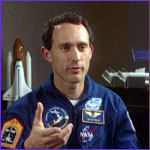 See Newman in
See Newman in See Gernhardt in
See Gernhardt in